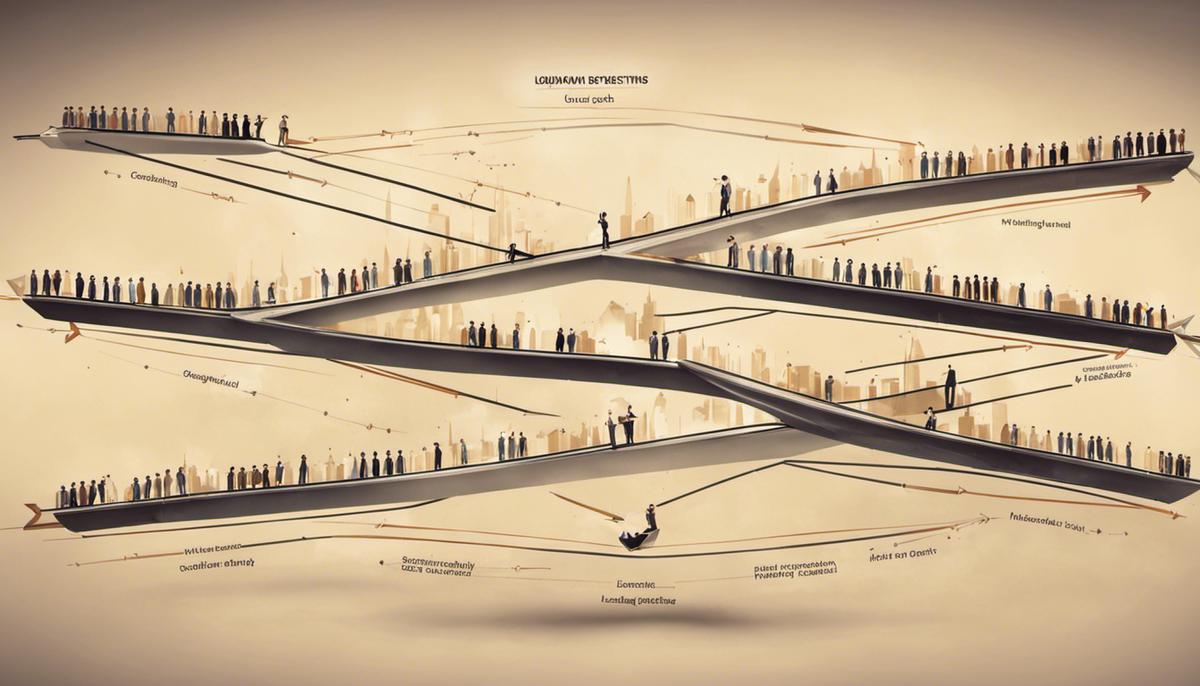In today’s fast-paced, disruptive, and competitive business landscape, the old methods of command-and-control leadership are growing increasingly ineffective. Agile, adaptive, and participative leadership models are taking the center stage, with decentralized leadership standing at the forefront. This unique leadership model, characterized by the dispersion of decision-making powers across all levels of the organization, has the potential to reshape and revitalize modern businesses. It is important, now more than ever, for professionals to understand how decentralized leadership differentiates from the traditional hierarchical model and the potential benefits it can offer to an organization.
Understanding the concept of Decentralized Leadership
Decentralized Leadership: Unleashing the Power of Innovation and Agility
In the constantly evolving business landscape, the traditional hierarchical model of leadership has witnessed some significant challenges. One concept challenging the status quo is decentralized leadership. In broad strokes, decentralized leadership involves distributing decision-making powers throughout the organization rather than concentrating it within a single centralized authority. But why has such a seemingly risky approach gained traction?
Innovation is the currency of the modern market, and decentralized leadership is a pathway to that treasure trove. With decision-making powers shared throughout an organization, more stakeholders have the room to experiment, take risks, and contribute to the overall direction of the company. The result? A smorgasbord of ideas pushing boundaries, daring to fail, and ultimately, paving the way for groundbreaking products and services.
Moreover, decentralized leadership empowers employees by giving them a direct stake in the company’s future. This empowerment fosters engagement, commitment, and enables individuals to tap into their full potential. When every member feels like an essential puzzle piece in the company’s masterpiece, productivity surges.
Decentralized leadership is also the golden ticket to agility. In today’s fast-paced corporate world, the ability to pivot quickly in response to market changes is the dividing line between industry leaders and stragglers. When a single authority is responsible for key decisions, delays are often inevitable. But with a decentralized approach, decisions can be made precisely and swiftly, keeping businesses on the leading edge.
However, it’s crucial to understand the challenges that come with this approach. Decentralized leadership is not a silver bullet for every organization. It requires a mature, transparent work environment where communication flows freely. This necessity often acts as a barrier for companies steeped in traditional chain-of-command cultures.
Additionally, striking a balance between autonomy and chaos is a tightrope walk every decentralized business needs to master. Too much freedom without adequate structure and accountability can lead to disarray, while an overly rigid framework can stifle creativity and innovation.
In conclusion, understanding what decentralized leadership entails and its importance is instrumental in today’s ever-changing market. It presents tantalizing potential benefits like fostering innovation, boosting employee engagement, and enabling rapid response to market changes – but it requires careful navigation. Companies brave and savvy enough to grapple with these challenges can enjoy the fruits of a more engaged, innovative, and agile organization. Bear in mind that no leadership style is a panacea; it’s critical to scrutinize the contours of each approach against the unique needs and culture of an organization.

Decentralized Leadership vs Traditional Hierarchies
Title: Decentralized Leadership Vs Traditional Hierarchical Systems – An In-depth Exploration
In the fast-paced, rapidly evolving landscape of today’s business world, the role and structure of leadership are being challenged. Decentralized leadership, an approach that disperses decision-making across an organization instead of concentrating it in a few top-level executives’ hands, arises as a transformative solution against the rigidity of traditional hierarchical systems.
One may ask, ‘How does decentralized leadership line up against the time-tested hierarchical system?’ Let’s delve into this intriguing discussion on the redistribution of power and authority patterns within organizations.
Direct confrontation against the gale of globalization, digital innovation, and other transformational changes is one of the distinctive features of traditional hierarchical systems. Under this pyramid structure, decision-making occurs at the top, with executives fiercely navigating through the wind. However, this implies a slower response rate due to excessive bureaucracy, lack of agility, and a heavy reliance on a few individuals’ decisions. This model becomes increasingly resistant to adapting to the increasingly complex, dynamic business environment.
Alternatively, decentralized leadership rides the wave rather than fights against it. This approach allows for quick and agile responses to change. Moreover, it encourages innovation by tapping the collective intelligence of the entire organization. However, winning with this strategy requires a culturally fit workforce, highly mature, and capable of handling power responsibly.
One critical question lurks in the background of the decentralized leadership discourse: Does it have an upper hand over traditional methods?
While it’s easy to give a resounding ‘Yes’ considering its many attributes in favor of today’s world, a closer inspection of its viability is essential. Decentralized leadership isn’t a one-size-fits-all answer. Instead, its effectiveness relies heavily on the organization’s cultural and structural dimensions, market conditions, and industry type. In contrast, a traditional hierarchical model still holds validity for organizations inclined towards more control and constraint.
In the end, striking a balance between the two approaches might be key to ace the organizational leadership game. The design of the balance would be as unique as the organization itself, incorporating elements of both frameworks to engineer an optimal leadership model.
Furthermore, the continuous navigation of cultural and organizational dimensions is critical when implementing a decentralized leadership style—keeping in view the need to reconcile organizational necessities with the intrinsic need for a transparent, empowering and mature work environment.
As we venture deeper into the 21st century, the impact of increasingly intricate markets and speedy technological advances will continue to shape leadership styles. The dialogue between decentralized leadership and traditional hierarchical systems is no power struggle; it’s an enabler, a creator of organizational directions that foster dynamic growth in our ever-evolving world.

Key advantages of Decentralized Leadership
In the ever-evolving landscape of business, the advantages offered by a decentralized leadership structure have not gone unnoticed. Providing a unique, innovative approach to leadership, this strategy can carve a path towards new opportunities, yielding significant advantages for companies keen on leveraging it appropriately.
A prime advantage businesses gain with a decentralized leadership style is improved decision making. When employees on various levels have the autonomy to make choices, they can bring a breadth of perspectives that leads to more well-rounded and data-driven decisions. By decentralizing power, businesses enable knowledge-sharing and idea generation from multiple sources, fostering creativity, diversity of thought, and unlocking potential solutions that would possibly be overlooked in traditional hierarchical models.
Further, decentralized leadership allows a company to pivot swiftly in response to fluctuating market conditions. This structure harnesses the individual knowledge and unique expertise of employees across the organization, facilitating quick, informed decision-making and enabling rapid adjustments. It’s like a swift sailboat catching even the lightest hint of wind, capitalizing on subtle nuances to change direction.
From a talent development perspective, employee engagement and job satisfaction significantly increase when staff members are given the responsibility and latitude to contribute in meaningful ways. Fostering a decentralized environment where employees are emboldened to take ownership of their roles can significantly boost morale, productivity, and results, contributing to an overall increase in the company’s bottom line.
Another notable advantage to decentralization is its adaptability to a remote work environment. With the rise of remote workforces, businesses need structures that can seamlessly foster collaboration, communication, and productivity in a digital arena. Decentralized leadership not only nurtures this environment, it thrives in it, paving the way for seamless operations outside the typical office confines, pushing the boundaries of innovation and growth.
Lastly, a decentralized leadership structure can contribute significantly to an organization’s resilience. When decision-making is distributed across different levels, it lessens the impact of potential losses to leadership. Challenges or setbacks can be absorbed more readily, ensuring continuity, flexibility, and resilience.
The journey towards decentralized leadership may not be without bumps but handled effectively, this forward-thinking approach can reshape an organization, encouraging innovation, agility, and resilience. Organizations now have the choice to break free from a rigid, hierarchical structure and orchestrate a new symphony of success with decentralized leadership. The advantages are numerous, and the opportunities vast – it’s about striking the right chord, and in this increasingly dynamic business environment, adopting a decentralized leadership model might just be the perfect harmony.

Challenges and Solutions of Decentralized Leadership
Even when an organization is primed for decentralized leadership, several obstacles may spring up along the path to implementation. These detriments, once identified, can be managed effectively to assure the best transition possible.
The first major hurdle is resistance to change. Humans are creatures of habit, and any significant shift, especially in a business setting, can generate discomfort among employees at all levels. Stakeholders, too, may express concerns about the lack of clear leadership and the potential for chaos. In fact, embracing a decentralized model does not entail removing all hierarchy or structure. Rather, it empowers employees to take on leadership roles in their specific areas of expertise.
Managing this change involves clear communication to all parties involved about the anticipated benefits of this pivot. This entails explaining the difference between complete absence of hierarchy (chaos) and decentralization (strategic distribution of authority). Ensuring an open conversation where opinions, concerns, and suggestions are heard and considered is crucial in fostering buy-in from all stakeholders.
Secondly, potential loss of control and accountability is a concern. In a decentralized leadership framework, decision-making powers are distributed across the board. This raises questions about who to hold accountable in case of failures. Overcoming this hurdle involves establishing robust structures to ensure accountability without stifling the empowerment gained from decentralization.
The delegation of authority must be accompanied by determined benchmarks for performance evaluation and clear expectations. In fact, the flexibility of decentralized leadership encourages individual accountability, as employees gain an augmented understanding of their contributions towards the company’s goals. It cultivates a sense of ownership amongst teams, creating an environment where individual and collective responsibility thrive.
Another key challenge arises with maintaining coherence and consistency across various teams and departments. With multiple decision points, there’s an increased likelihood of disparate strategies pulling the organization in different directions. Surmounting this problem requires establishing strongly-aligned objectives and values.
A shared vision is a binding force in decentralized leadership. It gives all teams a common focus while allowing them room to maneuver within that scope. Prioritizing alignment in this framework does not stunt autonomy – it provides a shared direction while allowing diverse teams to exercise their discretion in achieving these objectives.
Finally, installing a decentralized leadership system is not a one-size-fits-all recipe. Different industries, companies, and even departments within one company may require varying degrees of decentralization. Preserving the optimal level of decentralization for varying contexts is at the core of reaping its benefits fully.
In conclusion, implementing decentralized leadership may pose several obstacles, but the key lies in viewing these challenges as guideposts for the transition. By understanding these hurdles, organizations can create strategies to overcome them, optimizing the decentralized system to best support their objectives, culture, and stakeholders. This approach not only resolves transient problems but also creates long-lasting structures that underpin the ongoing function and viability of decentralized leadership.

Real-world Examples of Decentralized Leadership
While the debate on centralized versus decentralized leadership heats up in the business corridors, many modern organizations are sidestepping opinions and centering their focus on real-world applications – and they’re finding success. Not just an academic concept, decentralized leadership is becoming an active solution to the evolving landscape of leadership challenges. Successful examples of companies which have leveraged decentralized leadership to pioneer growth and innovation abound.
Startups have always been a breeding ground for innovation, leading the charge in trailblazing leadership styles. Take for instance the sharing economy giant, Airbnb. Here, decisions aren’t made in the corner office, rather, it’s the hosts and guests across the globe who call most of the shots in terms of service delivery and feedback. With their community-powered approach, this highly decentralized model has allowed Airbnb to rapidly expand its footprint, adapt to fluctuating market demands, and build a loyal user base.
Meanwhile, big tech giant Google has taken decentralized leadership to new heights. Rather than concentrate power, the company has made its mark by vesting decision-making power to individual teams, thereby promoting agility and fast-paced innovation. This model has resulted in continuous product enhancement and the birth of countless new services ranging from Gmail and Google Maps to Android and YouTube.
Problem-solving platform, Valve Corporation, similarly adopts a decentralized model, wherein there are no formal bosses or job titles – a strategy that empowers employees to take ownership of their work. This structure leads to increased employee satisfaction, heightened innovation, and remarkable adaptability.
Shapeshift, a cutting-edge digital assets platform, practices a holacracy model. This gives each team member autonomy within their realm of expertise, which leads to decisive, action-oriented outcomes. The platform’s rapid growth in the highly competitive cryptocurrency market can be attributed to this nimble and decentralized leadership approach.
Decentralized leadership shouldn’t be seen as the anti-thesis to hierarchy but as a revitalizing complement. Netflix, for instance, maintains a balance of central control with distributed decision-making. Leaders establish high-level strategic direction and cultural norms, while teams enjoy autonomy to innovate and make decisions on their own – a happy equilibrium resulting in the streaming service titan’s dominance in the industry.
Gore-Tex, a renowned multinational manufacturing company famous for its innovative fabric products, is another great example of decentralization in action. The company adopts a “lattice” organizational structure, where there are no traditional organizational charts, no chains of command, or predetermined channels of communication. This creates a work environment based on natural leadership and direct communication lines, inspiring employee creativity, and rapid product development.
Ultimately, decentralized leadership isn’t a one-size-fits-all manual to bypass leadership challenges; it’s a highly adaptable concept that empowers employees and fosters innovation in the right organization. Leveraging its adoption with scalability, organizational readiness, and a commitment to nurture a talent pool that thrives in such an environment ensures that the transformation translated into a decentralized framework is not just a leadership experiment but a game-changing move.

In an age marked by rapid innovation, intense competition, and a constant thirst for differentiation, decentralized leadership emerges as a potent tool to propel an organization’s growth and profitability. By harnessing the collective intelligence and empowering employees at all levels, it breaks barriers and fosters a culture that values adaptability and agility over rigid, stagnant hierarchies. Through real-world examples, we’ve shown how successful implementation of a decentralized model has triggered unprecedented growth and success. However, shifting to a decentralized leadership model doesn’t come without its challenges. By developing a keen understanding of these challenges, devising effective strategies, and learning from businesses that have already blazed this trail, any organization can leverage the unique benefits of decentralized leadership. The key to unlocking limitless possibilities lies in our willingness to usher in transformative change, and decentralized leadership might very well be that key.
